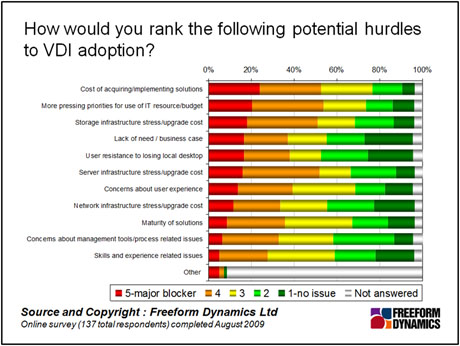In a previous article
in this series we highlighted growing interest in deploying virtual desktop solutions of a variety of flavours. Interest is fine, but any organisation looking to utilise such systems to a significant degree knows that it requires good management tools and, more importantly, excellent management processes and procedures.
There is already a lot of best practice for managing virtual environments in general that can be applied in the context of the desktop. But what are the key new approaches and requirements that IT needs to consider to be sure that, whatever the chosen mode of bringing virtualisation into the desktop environment, an appropriate level of control and overall management capability is maintained?
The chart below illustrates potential hurdles to desktop virtualisation adoption, with particular reference to VDI. As we can see, skills and experience related issues are seen as one of the least troublesome aspects to virtual desktop adoption. Concerns about management tools and process-related issues attract higher responses, but are still relatively low in the list. This should raise a red flag, as long term these factors will come to dominate ongoing operational costs. Many companies are more concerned with the short-term tactical concerns when considering the costs of VDI, but they should be equally looking at making sure the hydra does not spawn too many heads.

Without taking close account of the ongoing management costs, especially the often invisible but significant costs associated with supporting unmanaged desktops today, the business case for desktop virtualisation may hinge on acquisition costs. Early experience highlights that, under these circumstances, making an acceptable business case can be difficult to achieve in short enough timescales to convince the CFO. Good management practice around virtualised desktops offers opportunities to reduce ongoing maintenance costs whilst improving availability of systems to users through the rapid deployment of virtual desktop images in cases of user or application initiated system corruption.
So we have identified that management is not a concern according to poll respondents, but experience suggests that it should be. With desktop virtualisation still in its infancy as a broadly adopted approach, just where can management best practice be found? We have identified two areas that can offer guidance, one in the closely related area of server virtualisation and the other from existing desktop management best practice.
From the rapidly maturing server virtualisation space we have seen how important it is to get the sizing of the central systems correct. In desktop virtualisation terms this often means that special attention needs to be paid to performance monitoring, storage and network architecture and administration, especially to avoid performance slowdowns at times of peak usage, for example during the Monday morning staff arrival rush. But before this can be achieved, there is a need to rationalise the number of desktop images that need to be hosted in order to minimise operational management and central disk storage, all major contributing factors of cost and performance.
To achieve this, it helps to have an accurate picture of what applications and services are being used by whom and to what business purpose. Asset management and discovery tools have a major role to play here, along with heartfelt conversations with line of business managers to establish, publicly, why different sub-groups need to have their own CRM or other application rather than using the established company standard. One example of best practice that some early adopters of desktop virtualisation solutions cite, involves the management overhead associated with “Gold images” and application packages. Limiting these is essential to reduce ongoing costs as well as potentially reducing application licensing and support and maintenance fees. In truth this should also be best practice in all desktop support organisations but is one that is frequently overlooked or ignored as it can become very political.
Standard desktop management tools also have important roles to play in virtual desktop solutions. Equally it should be recognised that the move to desktop virtualisation will still burden the support desk with the usual problems that users always generate. Complaints around “I don’t know how to do it…”, will not go away and nor will the proverbial password resets. In particular, the importance of monitoring tools cannot be overstated, especially in the area of performance monitoring.
So where can the new procedures be found? Well it is always helpful to chat with your peers here on the Reg, to find out what they do if they are already using desktop virtualisation in anger, or you can try to work it out for yourself from the ground up. Another option is to ask suppliers of the proposed desktop virtualisation solutions, along with their delivery partners. But we have heard contradictory judgments concerning the value of such sources of best practice. On the one hand they take the form “We couldn’t have done it without them,” whilst at the other end of the spectrum, “Why did we have to spend our money for them to learn on the job?” may be heard in anguish.
This raises the opportunity for vendors to put their money where their mouths are, and to demonstrate their own best practice capabilities in the real world. In principle, enterprise desktop management lends itself to a “risk-sharing approach”, where vendors and their partners could offer improvement guarantees around desktop service levels and – or – operational costs – and if they fail, provide a discount on the project. The challenge will be to get all parties to agree on the means of measuring service levels and operational costs, both of which are non-trivial tasks. To make either a runner operationally will involve a considerable degree of mutual trust. We would be very interested to hear your experiences of these matters and your ideas on what vendors could do to speed your desktop virtualisation plans.